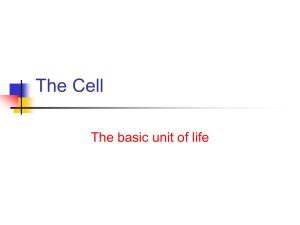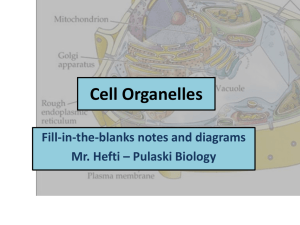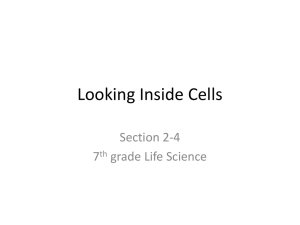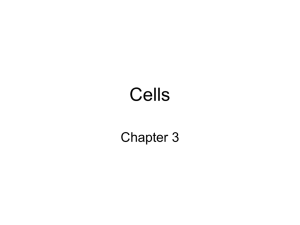Organelles
advertisement
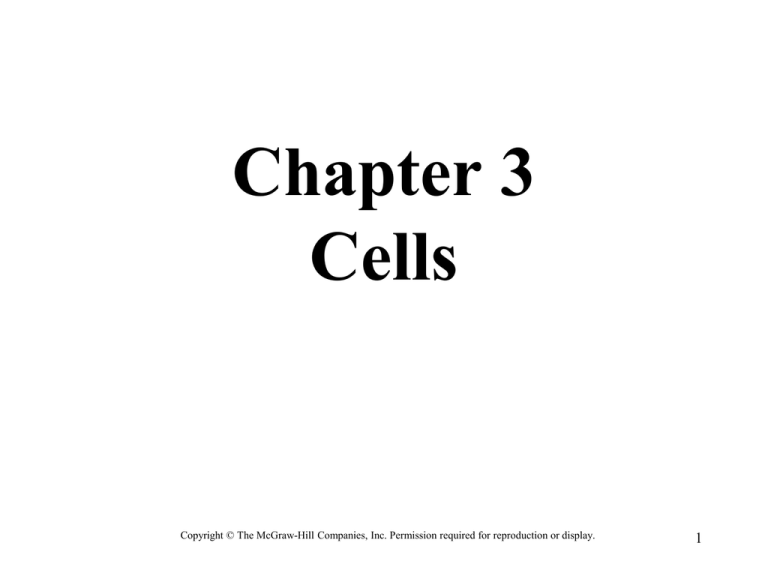
Chapter 3 Cells Copyright © The McGraw-Hill Companies, Inc. Permission required for reproduction or display. 1 Introduction • The basic organizational structure of the human body is the cell. • There are 50-100 trillion cells in the human body. • Differentiation is when cells specialize. • As a result of differentiation, cells vary in size and shape due to their unique function. 2 A Composite Cell Copyright © The McGraw-Hill Companies, Inc. Permission required for reproduction or display. • Also called a ‘typical’ cell • 3 Major parts include: • Nucleus • Cytoplasm • Cell membrane Phospholipid bilayer Flagellum Nucleus Chromatin Nuclear envelope Nucleolus Ribosomes Cell membrane Basal body Microtubules Rough Endoplasmic reticulum Centrioles Mitochondrion Smooth Endoplasmic reticulum Microvilli Secretory vesicles Cilia Golgi apparatus Microtubule Microtubules Lysosomes 3 Cell/Plasma Membrane • Outer limit of the cell • Controls what moves in and out of the cell – allows cells to receive and to respond to incoming messages • Selectively permeable • Phospholipid bilayer • Water-soluble “heads” form surfaces (hydrophilic) • Water-insoluble “tails” form interior (hydrophobic) • Permeable to lipid-soluble substances • Cholesterol stabilizes the membrane • Proteins: • Receptors • Pores, channels and carriers • Enzymes • CAMS • Self-markers 4 Cytoplasm • Cytosol = jelly-like fluid (70% water) that holds the cellular organelles and occupies the space between the nucleus and cell membrane. It contains abundant protein rods and tubules that form a supportive framework (cytoskeleton) • Organelles = solids Cytoplasm is really like a Jello fruit salad where the Jello is the cytosol and the fruits (oranges, grapes, bananas, maybe walnuts, etc.) are the organelles. 5 Organelles Endoplasmic Reticulum (ER) • A network of interconnected parallel membrane, canals, vesicles and sacs, that is continuous with the nuclear membrane; •Transport system • Rough ER (RER) Copyright © The McGraw-Hill Companies, Inc. Permission required for reproduction or display. Membranes Membranes • Studded with ribosomes • Function – Protein Synthesis • Smooth ER (SER) •lacks ribosomes (b) •Function = lipid & cholesterol synthesis •Added to proteins arriving from RER •Stores calcium ions •Abundant in liver cells (hepatocytes) •Break down of drugs Ribosomes (c) 6 Organelles Ribosomes 1. Free floating small granules dispersed throughout the cytoplasm and on the membranes of some endoplasmic reticulum (as rough endoplasmic reticulum) 2. Composed of RNA and protein 3. Function = protein synthesis. 4. Not bound by a membrane 5. Provide structural support and enzyme activity to amino acids to form protein. 7 Organelles Golgi apparatus • Stack of flattened, membranous sacs (cisternae), arranged in stacks, that modify, package and deliver proteins. •Associated with many vesicles (membrane bound sacs containing proteins) •Function = modification, packaging, and transport of proteins; Vesicle •Membranous sacs that store substances. •Vesicles pinch off as “secretory vesicles”, which are transported out of the cell. 8 Organelles Mitochondria (Con’t) • Kidney-shaped organelle whose inner membrane is folded into shelf-like partitions called cristae: •“Powerhouse” of the cell = site of cellular respiration, where energy is released from glucose. •Contains their own DNA & RNA 9 Organelles Lysosomes • Spherical membranous sacs containing digestive enzymes (acid hydrolases) • “Suicide sacs” which destroy anything the cell no longer wants or needs - Digest ingested bacteria, viruses, and toxins • Degrade nonfunctional organelles • Break down and release glycogen • Break down bone to release Ca2+ Organelles Peroxisomes •Membranous sacs containing oxidase enzymes •Function = detoxification of harmful or toxic substances (i.e. alcohol, formaldehyde, oxygen free radicals - highly reactive chemicals with unpaired electrons) •Breaks down organic molecules •H2O2 11 Organelles Centrosome: •Pair of microtubules located near the nucleus •Two rod-like centrioles • Used to produce cilia and flagella • “Cell center” near nucleus • Generates microtubules; organizes mitotic spindle • Contains centrioles: Small tube formed by microtubules 12 Organelles Copyright © The McGraw-Hill Companies, Inc. Permission required for reproduction or display. Cilia (pl)/Cilium(s) • Short hair-like cellular projections • Propel substances through passageways and on cell surface •Located in the lining of trachea and fallopian tube. (a) a: © Oliver Meckes/Photo Researchers, Inc. Flagella (pl)/Flagellum (s) • Long tail-like projection • Only one per cell in humans • Provides motility to sperm •Aids in cell locomotion 13 © Colin Anderson/Brand X/CORBIS Organelles Microvilli: • Fingerlike extensions of plasma membrane/external surface of the cell. • Function = to increase surface area for absorption • Core of actin filaments for stiffening 14 Organelles CYTOSKELETON: Microfilaments, microtubules and intermediate filaments • Elaborate series of thin rods and tubules throughout the cytosol. •Support cytoplasm Microfilaments: • Dynamic actin strands Microtubules: • • • Dynamic hollow tubes Most radiate from centrosome Determine overall shape of cell and distribution of organelles Intermediate Filament attached to cytoplasmic side of plasma membrane • Involved in cell motility, change in shape, endocytosis and exocytosis • Tough, insoluble ropelike protein fibers • Resist pulling forces on the cell and attach to desmosomes 15 Cell Nucleus •Control center of the cell •The largest organelle of the cell • Genetic library with blueprints for nearly all cellular proteins • Responds to signals and dictates kinds and amounts of proteins to be synthesized • Most cells are uninucleate • Red blood cells are anucleate • Skeletal muscle cells, bone destruction cells, and some liver cells are multinucleate • Contains 3 different regions: • Nuclear envelope • Nucleolus • Chromatin 16 Cell Nucleus • Nuclear envelope Copyright © The McGraw-Hill Companies, Inc. Permission required for reproduction or display. •Porous double membrane • Separates nucleoplasm from cytoplasm • Outer layer is continuous with rough ER and bears ribosomes • Inner lining (nuclear lamina) maintains shape of nucleus • Pore complex regulates transport of large molecules into and out of nucleus • Chromatin • • • Nucleus Threadlike strands of DNA (30%), histone proteins (60%), and RNA (10%) Arranged in fundamental units called nucleosomes Condense into barlike bodies called chromosomes when the cell starts to divide. Nuclear envelope Nucleolus • Nucleolus • Dark-staining dense spherical bodies within the nucleus (a) •Collection of RNA and proteins •Function = synthesis of ribosomes Chromatin Nuclear pores 17




